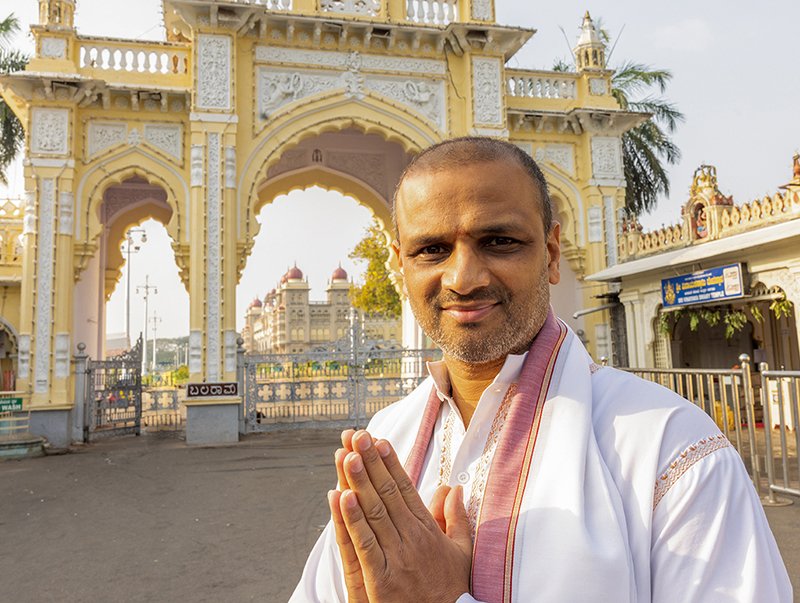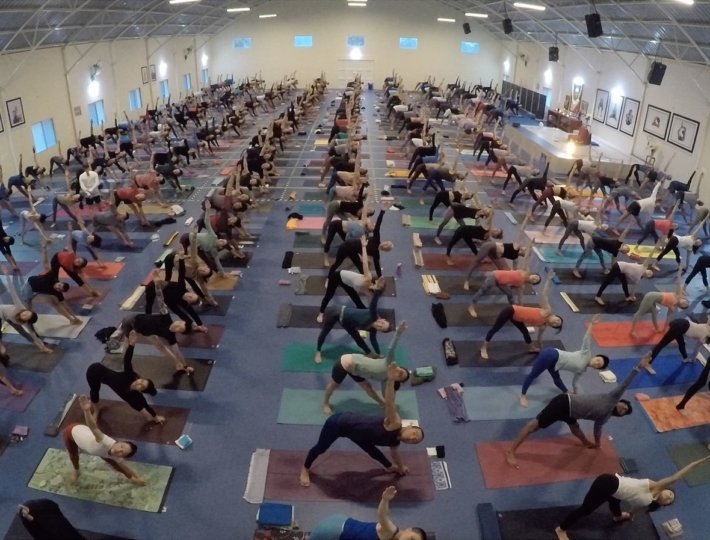Long before the first recorded attempts to apply modern scientific methods to the study of yoga in the 19th century, the ability of this practice to enhance health and prolong life has been the focus of scholarly attention. A millennium ago, revered Central Asian Muslim scholar, Al-Bīrūnī, translated Patanjali’s Yoga Sutras and his take on Ayurveda into Persian, promoting yoga’s potential in the Indo-Islamic courts of South Asia. Fast-forward to 1966, B.K.S. Iyengar’s Light on Yoga was pioneering for its index of poses and citations on the medicinal properties of each asana. Meditation, too, has been on the medical radar, according to ancient Buddhist texts from India.
The contemporary emphasis on the health benefits of yoga and mindfulness practices—broadly understood to include posture, breathing, and meditation—is, in many ways, just the latest chapter in a symbiotic relationship between wellness and the science of healing that is centuries long and global in scope. Below, are just a handful brilliant minds now leading the research on the benefits of these ancient practices with the goal of answering the fundamental question: How exactly do yoga and mindfulness heal?
WILLOUGHBY BRITTON, PhD
Director of Brown University’s Clinical and Affective Neuroscience Laboratory
What she studies: Mindfulness-based interventions for mood and anxiety disorders. Her work is distinctive among contemporary research in its recognition of two basic realities. First, while mindfulness practice is based in part on the 2,500 year-old teachings of Gautama Buddha, there are an enormous variety of approaches to meditation. Second, these many forms are likely to have greatly varied effects on different populations. Even presumably standardized meditations often include multiple distinct approaches, such as open-awareness and concentration, each with its own psychophysiological and neurocognitive effects.
Why it’s groundbreaking: By differentiating between meditative approaches, her work has been able to document practice-specific effects and, thereby, advance toward meditation safety in a variety of institutional settings or, in her words, finding out “which practices are best or worst suited for which types of people or conditions and why.”
SAT BIR SINGH KHALSA, PhD
Assistant Professor of Medicine at Harvard Medical School, Associate Neuroscientist at Brigham and Women’s Hospital, and Research Director for Kripalu Center for Yoga and Health
What he studies: The clinical uses of yoga for insomnia, stress, anxiety spectrum disorders, and mental health in Boston-area public schools and the workplace. Citing both his own multiple decades of work and current research in the growing field of medical yoga, he emphasizes the integrated nature of each component, offering the example of how breathing practices cause a relaxation response and a consequent impact on the autonomic nervous system. Over time, this results in greater mind-body awareness, an ability to reduce stress through emotional self-regulation, and, ultimately, the possibility of a “meditative-cognitive component.”
Why it’s groundbreaking: While each discrete component contributes to health and wellness, it is this last element of meditation that he credits with extraordinary, long-term benefits as a practitioner’s increased mind-body awareness leads to permanent, positive behavioral and cognitive changes. “When evidence builds to a critical mass, policy inevitably follows,” he says. “For example, in the 1950’s, there were just about the same number of studies on cigarette smoking as there are on yoga today. Society will remain ignorant of the mind-body connection at its own peril, but the change will come.”
INA STEPHENS, MD
Pediatric Infectious Disease Specialist and Co-director of the Medical Yoga at the University of Virginia Medical School
What she studies: Disorders, including anxiety, mild depression, chromic pain, asthma, ADHD, and high-functioning autism, that can be treated with yoga-based interventions. Noting the mental health epidemic affecting today’s youth and referencing recent studies suggesting that up to half of all teens have complaints related to stress, anxiety, and/or depression, she has turned to yoga as a powerful mindfulness practice for promoting teen mental health.
Why it’s groundbreaking: Yoga practice turns on parasympathetic tone and, therefore, modulates the body’s stress response systems. With increased balance to the autonomic nervous system comes the decrease in stress response hormones (neurotoxins like cortisol), lowering blood pressure and increasing of heart rate variability. Additional benefits include increased levels of natural “happy neurotransmitters,” such as GABA, serotonin, melatonin and oxytocin, and the reduction to the size of the amygdala, which is the brain’s threat center, responsible for fear, anxiety and stress. She rejects the qualifier “alternative” for yoga-based interventions, insisting that these tools need to be understood as a complement to Western Medicine rather an alternative. Her own health journey serves as a testament: After having open-heart surgery to treat a heart defect, she took no pain medication beyond the first day following procedure. Within three weeks, she was up and practicing yoga.
RELATED: The Yoga Boom in Western Medicine
JOHN RETTGER, PhD
Clinical Researcher and Director of Mindfulness at Stanford University School of Medicine, and Sonima’s resident psychologist
What he studies: The impact of trauma exposure on child development through the core components of research, clinical work, and community outreach. He has been the principle meditation coordinator for an unprecedented effort to implement a yoga-based mindfulness intervention in the economically depressed Ravenswood school district in East Palo Alto, CA, and track its effects on K-8 grades through a three-year longitudinal study.
Why it’s groundbreaking: The transformational power of yoga and yoga-based mindfulness, he explains, lies in its ability to bring about tolerance of the difficult experiences we inevitably encounter as human beings. With the cultivation of this “affect-tolerance” comes the ability to reach a sense of harmony in which we no longer need to be damaged by difficult experiences.
BILL BUSHELL, PhD
Director of Research & Academic Liaisons at the Integrative Studies Historical Archive & Repository (ISHAR), an initiative of The Chopra Foundation
What he studies: The extraordinary psychophysical abilities demonstrated by long-term, virtuoso practitioners of a great variety of contemplative traditions with significant family resemblances to Indic yoga, including Tibetan, Sufi, Ethiopian Christian, and East Asian traditions. Yogis in these traditions, while in states of trance, have been known to withstand normally lethal conditions, including the freezing cold, fire, poison, disease, and oxygen deprivation. Bushell has observed and documented examples of exceptional physical performance by yogic adepts, who seem to exhibit immune enhancement and ability to resist pathology. For example, one Tibetan lama apparently healed himself of gangrene through meditation.
Why it’s groundbreaking: Bushell points to the harmful role of inflammation in a great majority of illnesses and physical trauma. Moreover, virtually every infectious condition, from the flu to malaria, causes damage to an organism due to an overreaction of the the immune system. Yogic adepts seem to do on a large, sustained scale what regular practitioners are also doing. That is, yogis are tapping into the profound healing effects of the nervous system, particularly that of the vagal nerve complex, which branches all over the body and through neurotransmitters appear to turn off inflammatory markers. Yoga, accordingly, is not only about healing; it is about protection from pathology and achieving optimal functioning.









Comments (0)